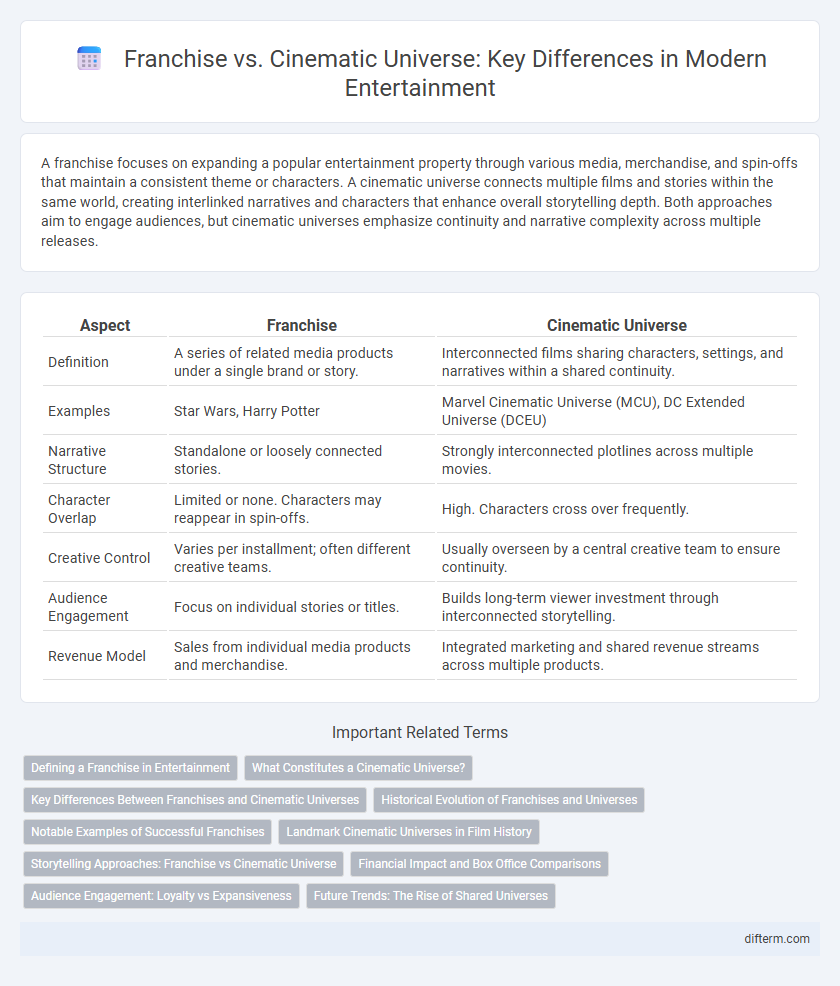A franchise focuses on expanding a popular entertainment property through various media, merchandise, and spin-offs that maintain a consistent theme or characters. A cinematic universe connects multiple films and stories within the same world, creating interlinked narratives and characters that enhance overall storytelling depth. Both approaches aim to engage audiences, but cinematic universes emphasize continuity and narrative complexity across multiple releases.
Table of Comparison
| Aspect | Franchise | Cinematic Universe |
|---|---|---|
| Definition | A series of related media products under a single brand or story. | Interconnected films sharing characters, settings, and narratives within a shared continuity. |
| Examples | Star Wars, Harry Potter | Marvel Cinematic Universe (MCU), DC Extended Universe (DCEU) |
| Narrative Structure | Standalone or loosely connected stories. | Strongly interconnected plotlines across multiple movies. |
| Character Overlap | Limited or none. Characters may reappear in spin-offs. | High. Characters cross over frequently. |
| Creative Control | Varies per installment; often different creative teams. | Usually overseen by a central creative team to ensure continuity. |
| Audience Engagement | Focus on individual stories or titles. | Builds long-term viewer investment through interconnected storytelling. |
| Revenue Model | Sales from individual media products and merchandise. | Integrated marketing and shared revenue streams across multiple products. |
Defining a Franchise in Entertainment
A franchise in entertainment is a collection of related media products, such as films, television series, books, and merchandise, all centered around a shared intellectual property or storyline. It typically includes sequels, spin-offs, and adaptations that expand the original concept while maintaining brand recognition and audience loyalty. Franchises generate long-term revenue streams by leveraging established characters, settings, and narratives across multiple platforms.
What Constitutes a Cinematic Universe?
A cinematic universe is defined by interconnected films sharing common characters, settings, and overarching narratives that build a cohesive world across multiple storylines. Unlike standalone franchises, cinematic universes emphasize continuity and character development, allowing for crossovers and expanded plot lines that deepen audience engagement. Key examples include the Marvel Cinematic Universe (MCU) and the DC Extended Universe (DCEU), which strategically intertwine individual movie plots into an integrated entertainment experience.
Key Differences Between Franchises and Cinematic Universes
Franchises typically consist of a series of related films, video games, or merchandise centered around a common character or theme but can vary widely in tone and storyline, whereas cinematic universes are interconnected film series with shared characters, settings, and continuous story arcs. Franchises may include standalone stories or loosely connected projects, while cinematic universes require narrative cohesion and chronological order to maintain continuity across multiple titles. Budget allocation, character development, and marketing strategies also differ, with cinematic universes generally demanding larger investments to ensure seamless integration and fan engagement.
Historical Evolution of Franchises and Universes
Franchises originated as isolated works like James Bond films, focusing on recurring characters without interconnected storylines, while cinematic universes emerged with Marvel Studios, integrating multiple characters and plots into a cohesive narrative across films. This evolution reflects a shift from standalone sequels to expansive storytelling ecosystems that boost audience engagement and cross-promotion. The historical progression highlights how franchises adapted to audience demand for continuity, leading to the structured, multi-layered worlds characteristic of modern cinematic universes.
Notable Examples of Successful Franchises
The Marvel Cinematic Universe (MCU) stands as a prime example of a highly successful cinematic universe, seamlessly integrating multiple interconnected films and TV series to build a vast, loyal fanbase. Iconic franchises like the Star Wars saga demonstrate the power of expansive storytelling across movies, television, books, and merchandise, establishing a multi-platform presence. The Harry Potter franchise, including the Wizarding World cinematic universe expansions, highlights how captivating narratives and character development drive long-term engagement and commercial success.
Landmark Cinematic Universes in Film History
Franchise films like James Bond offer standalone stories centered on iconic characters, while cinematic universes such as the Marvel Cinematic Universe (MCU) create interconnected narratives across multiple films. The MCU revolutionized film history by delivering cohesive storytelling through a series of interrelated installments, generating unprecedented box office success and fan engagement. Landmark cinematic universes like the MCU, DC Extended Universe, and Star Wars Expanded Universe have reshaped entertainment by blending individual film identities into broader, immersive worlds.
Storytelling Approaches: Franchise vs Cinematic Universe
Franchises often utilize standalone stories or loosely connected sequels, allowing flexible storytelling that targets diverse audiences without strict narrative continuity. Cinematic universes emphasize interconnected plots and character arcs across multiple films, creating a cohesive and immersive experience that encourages long-term viewer engagement. This approach enhances brand loyalty and deepens emotional investment through detailed world-building and cross-film storylines.
Financial Impact and Box Office Comparisons
Franchise films generate consistent revenue through established fan bases and brand recognition, often securing strong box office returns with sequels and spin-offs. Cinematic universes expand storytelling across interconnected films, boosting overall box office performance by encouraging audiences to watch multiple entries, increasing cumulative ticket sales. While franchises rely on individual blockbuster success, cinematic universes leverage cross-promotional synergies that maximize long-term financial impact and merchandise sales.
Audience Engagement: Loyalty vs Expansiveness
Franchise models often cultivate deep audience loyalty by building a consistent tone and recurring characters that foster strong emotional connections. Cinematic universes prioritize expansiveness, drawing viewers through interconnected storylines across multiple titles, encouraging immersive engagement over time. This strategy maximizes audience reach by appealing to diverse preferences within a shared universe, enhancing overall fan investment.
Future Trends: The Rise of Shared Universes
The rise of shared universes in entertainment signals a shift from isolated franchises to interconnected cinematic experiences, enhancing audience engagement through complex storytelling across multiple platforms. Streaming services and advanced visual effects technologies are pivotal in expanding these shared universes, enabling seamless integration of characters and narratives. Future trends indicate a growing investment in intellectual properties that support long-term, cross-media world-building, driving innovation and fan loyalty.
Franchise vs Cinematic universe Infographic

 difterm.com
difterm.com